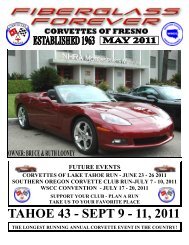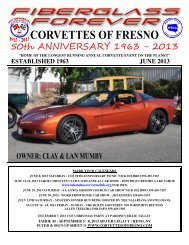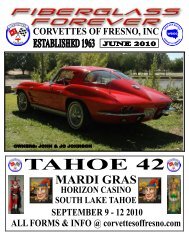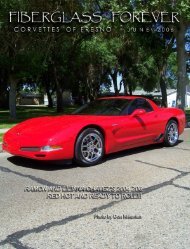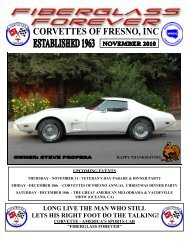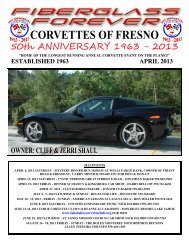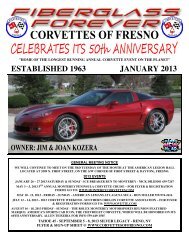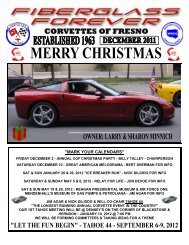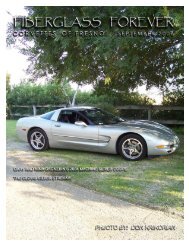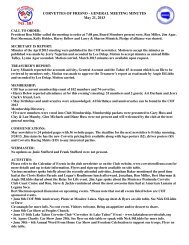Twas the Night Before Christmas - Corvette Style - Description ...
Twas the Night Before Christmas - Corvette Style - Description ...
Twas the Night Before Christmas - Corvette Style - Description ...
Create successful ePaper yourself
Turn your PDF publications into a flip-book with our unique Google optimized e-Paper software.
The clay bar is not supposed to be a well-kept secret. It's normally sold as part of detailing<br />
kits, many people still don't understand. It just works. Have you ever drawn your hand across<br />
your hood just after washing expecting smoothness only to feel lots of little bumps and bits of dirt<br />
everywhere? Late-model paints, once cured, are harder than old-fashioned enamels (especially<br />
<strong>the</strong> clear-coat), and will show minor abuse quickly. Tiny bits of sharp stuff like dust and metal<br />
fragments can stick into that clear-coat and normal washing won't remove <strong>the</strong>m. If you don't get<br />
rid of <strong>the</strong>m, <strong>the</strong> Grim Reaper is coming for your paint.<br />
The same effect of "dragging traction" encountered when drying with a chamois, which<br />
we described in <strong>the</strong> "Drying Don'ts" section, is what makes <strong>the</strong> clay bar so effective (but in a<br />
positive way). First off, <strong>the</strong> car must be freshly ba<strong>the</strong>d to use <strong>the</strong> clay, or <strong>the</strong> bar will choke on all<br />
surface-bound dirt and probably scratch <strong>the</strong> paint. When lightly rubbed over <strong>the</strong> surface of your<br />
clean paint, lubricated by a coat of detailing spray, <strong>the</strong> clay will pick up embedded particles in<br />
your paint that would o<strong>the</strong>rwise remain after washing.<br />
Clay bars pull out and shear off embedded particles and surface-born contaminants with a<br />
safe and effective lubricated mechanical action. The clay bar must be sliding on a film of detailer<br />
or it will stick to <strong>the</strong> paint and skip and leave trace clay deposits (which come right off with <strong>the</strong><br />
clay bar). While using a clay bar, knead it regularly (remold <strong>the</strong> working surface so fresh clay is<br />
exposed). When using instant detailer for clay work it can be wiped off in <strong>the</strong> same fashion as it<br />
would when used as a detailing spray. If <strong>the</strong> instant detailer dries it can be removed by spraying<br />
on more and drying it off immediately. If you drop <strong>the</strong> clay bar throw it away—period. This is<br />
why it's smart to use only a section of <strong>the</strong> clay bar while working, not all of it at once.<br />
Clay Facts: Clay bars will remove <strong>the</strong> wax from your vehicle's finish so be prepared to reseal<br />
<strong>the</strong> entire clay-barred portion of your paint. (For that reason don't use a clay bar unless<br />
your paint really needs it; o<strong>the</strong>rwise you'll just be making more work for yourself.) So if you plan<br />
to polish, seal and wax, do it after using a clay bar. When using clay consider <strong>the</strong> brand of clay<br />
you use—some are very hard and aggressive.<br />
Clay works well on plastic, trim and glass as well as on matte-finish plastics that are free of<br />
coatings. Clay bars can remove paint over-spray from chrome and paint and just about any<br />
o<strong>the</strong>r hard or shiny surface. Mo<strong>the</strong>rs® Clay Bar is safe for all automotive paints.<br />
The initial goal of preparing your paint is to eliminate all impurities and pieces of debris<br />
from <strong>the</strong> surface. Thorough washing followed by <strong>the</strong> clay bar should remove all offending<br />
particles and substances and leave <strong>the</strong> paint ready for polishing. This process of smoothing <strong>the</strong><br />
paint's surface rounds off <strong>the</strong> edges of surface-depth scratches, evens out <strong>the</strong> crinkling from any<br />
minor blemishes and erases <strong>the</strong> etching left by water spotting and more. It's like sanding a piece<br />
of wood with sandpaper but with a much, much finer medium.<br />
Of course, some scratches are just too deep to polish away—and not all marks and nicks<br />
can be fixed with elbow grease. If <strong>the</strong> damage is deep enough to catch your fingernail you may<br />
not be able to remove it entirely. If all else fails try a slightly stronger polish. When working a<br />
scratch with any polish you should rub against it from various angles opposite <strong>the</strong> direction of<br />
<strong>the</strong> scratch.




